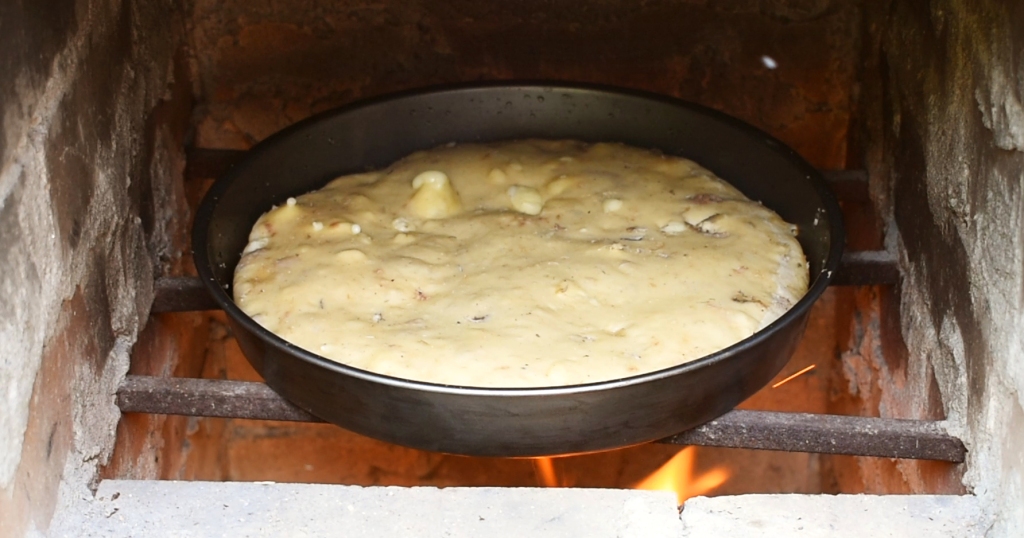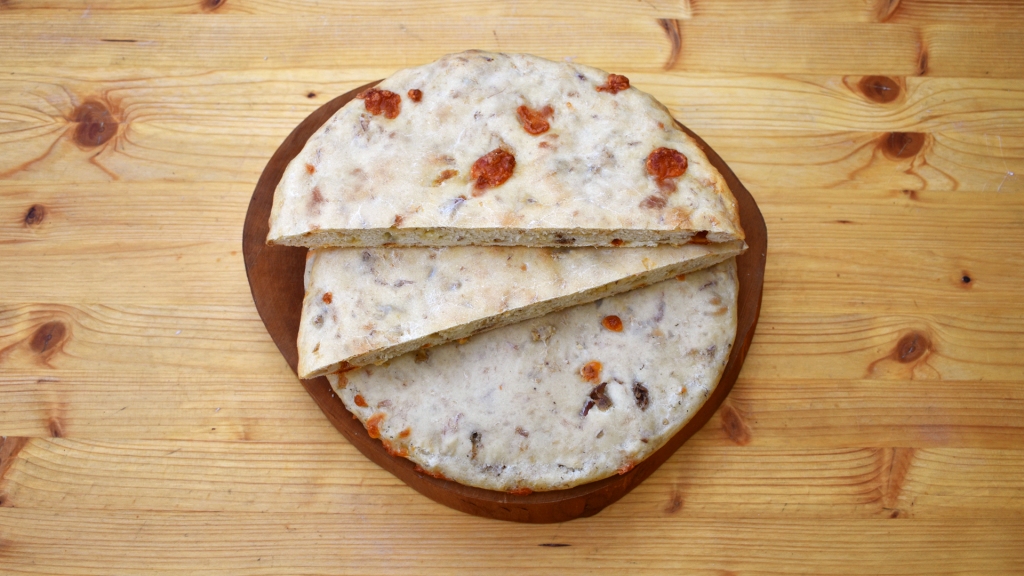Tantummoduo persolvere debeatis omni anno salutes in dies natali domini sive vos sive vestris heredes in suprascripto episcopio tam nobis quam a nostris posteris successores duodecim pizze et una spatula de porco; et unum lumbulum; simul et in die sanctum pascha resurrectionis domini annualiter duodecim pizze et unum parium de pulli .
“And in the same way, you have to give, you in person or your heirs, in the Day of the Nativity of our Lord, to us or our successors, twelve pizze and a pork shoulder, and a [pork] loin; and then, in the day of the holy Day of the Resurrection of our Lord, every year, twelve pizze and a couple of chickens.”
We find this passage in an entry dated year 997, in the Codex Diplomaticus Cajenatus, a medieval text which shows the first record of the word pizza. This source is a collection of official and notarial acts of the city of Gaeta, in this case, a contract with the local bishop for the rent of a water mill and the lands around it. Among the other payments, the contract includes this clause: each Christmas and Easter, the tenant will provide twelve pizze to the bishop, and other foods.
We do not know how this 10th-century pizza was made, but we have some information from later sources, De Honesta Voluptate et Valetudine by Platina, written in the 15th century, and L’Economia del Cittadino in Villa by Vincenzo Tanara, written in the 17th century. Platina’s book was written originally in Latin, but here we are using the translation into Italian, in which the Latin word placenta is correctly translated as piza or fugaza (in the various texts, we also find the spelling variants pitta or pinza, two words that still today are used to refer to traditional kinds of focaccia as well as sweets). Pizza, Tanara confirms, is a kind of pie, called in many ways, depending on the city and Italian region: placenta is one of them.
There are many ways to make pizza, both savory and sweet. The most simple consist in mixing flour, warm water, and cured pork fatback, with the addition of fennel seeds, Platina writes. But pizza, adds Tanara, is made in many ways: with cured pork fatback, oil, or butter; with almonds and walnuts; with sugar or honey; with vegetables, fruit, or meat mixed into the dough.
Today, we are preparing a pizza from Platina’s book, very different from modern pizza (which we find only in later sources, not before the 19th century) but incredibly good.
Below, you will find the original text with our translation, the method, and the video of the recipe with subtitles in English and Italian. Enjoy!
If you want to know more about historical pizza, read our book Early Italian Recipes. Cereals, bread, pasta, and pies, where you will find historical information about cereals and their preparations from the Antiquity to the end of the Renaissance, with 114 recipes for pasta, bread, pizza, pies, and more, newly translated and explained.
If you are interested in late-medieval cuisine, we recommend Libro de la Cocina. Medieval Tuscan Recipes and Registrum Coquine. A medieval cookbook. To learn about the transition between ancient and medieval cooking, check out De Observatione Ciborum, written by the physician Anthimus to the king of the Franks Theuderic. If you are interested in recipes for vegetables from the Antiquity to the beginning of the Modern Era in Early Italian Recipes. Vegetables, fruit, herbs, and flowers available in English and Italian.
For information about ancient cuisine, read Ancient Roman Cooking. Ingredients, Recipes, Sources. Moreover, full translations of historical sources and articles on ancient and medieval cooking are available on Patreon.
To support our work, you can buy us a beer or purchase our merchandise.

Ingredients (for 3 pizze)
400 gr white wheat flour
sourdough
3 quails
120 gr firm cheese
lard
salt
Method
Knead the flour with a couple of spoons of sourdough, salt, and warm water. Let the dough rest overnight.
Grease the quails with lard or oil and place them in the oven or spit-roast them, collecting their fat during the cooking. Cut the cheese into cubes.
Knead the dough with the deboned meat, the cheese, and the fat. Divide the dough into three parts and arrange each one of them in a round cooking vessel. Let them rest for at least half an hour.
Bake the pizza in the oven for about 20 minutes and serve it still hot.

Note about the ingredients
Platina suggests using bread dough. In this source, he writes to use flour sifted to remove the bran. As common in the Middle Ages and Renaissance, the bread has to be well salted and leavened. You find here more about bread in the Middle Ages.
The author does not specify which little birds to use for this recipe. We chose quails, but you can use other kinds of meat. Though they are not what the author intended, with chicken or duck you will obtain an excellent pizza anyway.
We used scamorza, similar to provatura (very popular in this period and made in the same way as one kind of cheese used by ancient Romans described by Columella), but you can use any kind of firm cheese, not excessively soft for a good outcome of the recipe.

Original text
Piza o fugaza […] Sono etiam et alcuni li quali poneno gli oceletti inel pane cum caxo fresco et grasso daperse de li ucelli; et in forno insieme si cuoceno.
Translation
There are some who place the little birds in the bread dough with fresh cheese and the fat collected from the [previously roasted] birds; and they bake them together [the author means “this dough”] in the oven.
Buy me a coffee
Patreon
Ancient Roman Recipes Playlist
Ancient Greek Recipes Playlist
Medieval Recipes Playlist
YouTube Channel
Merchandise
Books
Early Italian Recipes. Cereals, bread, pasta, and pies
Libro de la Cocina by Anonimo Toscano. Medieval Tuscan Recipes
Early Italian Recipes. Vegetables, fruit, herbs, and flowers
De Observatione Ciborum by Anthimus. Early-medieval recipes at the court of the Franks.
Registrum Coquine by Johannes Bockenheim. A medieval cookbook
Ancient Roman Cooking. Ingredients, Sources, Recipes
Translations of Historical Sources
De Agri Cultura by Cato – first part (2nd century BCE)
De Re Coquinaria by Apicius (Ancient Rome)
Apicii Excerpta by Vinidarius (5th or 6th century)
De Observatione Ciborum by Anthimus (6th century)
Appendicula de Condituris Variis by Johannes Damascenus (8th or 9th century)
De Flore Dietarum (11th century)
Tractatus de Modo Preparandi et Condiendi Omnia Cibaria (13th or 14th century)
Liber de Coquina – first part (14th century)
Enseignemenz (14th century)
Opusculum de Saporibus by Mainus de Maineris (14th century)
Libro de la Cocina by Anonimo Toscano (14th century)
Anonimo Veneziano (14th century)
Registrum Coquine by Johannes von Bockenheim (15th century)
Libro de Arte Coquinaria by Maestro Martino – parts 1-4 (15th century)
Recipes
Tuscan Chicken Soup with Unripe Grapes
Early-medieval Kohlrabi Stew
Tuscan Fried Leek Rings
Pork Ribs
Tuscan Pancakes with Wild Flowers
Hop Shoots
Shrimp – Savore de Gambari
Orange Frittata – Fritata de Pomerantiis
Tuscan Soup with Hen and Florence Fennel
The diet of the Franks – Celery Root and Beef Stew
Tuscan Fish Cakes – Salciccie di Pescio
Tuscan Stew with Pork Belly and Rutabaga
Pork and Onion Soup
Tuscan Radish Soup
The Diet of the Franks – Endive and Pork Jowl
Tuscan Fried Meatballs
The Diet of the Franks – Chicken Stew
Castagnazzi
Renaissance Stuffed Cucumbers
Pork Roast with Cherry Sauce
Renaissance Fried Tomatoes
Herbolata
The Diet of the Franks – Beef Stew
Fried Chicken Soup
Beef Roast with Garlic Sauce
Bread Soup
Salted Meat and Peas
Baghdadi Rice Cream
Chicken with White-Pepper Sauce – Piperatum Album
Indian Chickpeas and Meat
The Diet of the Franks – Pork Stew
Chestnut and Mushrooms
Lentils with Oregano and Watermint
Egyptian Bread with Pistachios and Almonds
Veal with Fennel-Flower Sauce
Pork Roast with Green Sauce
Eggs Poached in Wine
Brodium Theutonicum
Crispellae – Pancakes with Saffron and Honey
Brodium Sarracenium – Chicken Stew
Fava Beans and Pork
Erbe Minute – Meatballs with Herbs
Lettuce and Pork Soup
Zanzarelli – Egg and Cheese Soup
Turnip and Beef Soup for Servants
Cheese Pasta – Vivanda Bona
Gratonata – Chicken Stew
Chickpea Soup with Poached Eggs
Apple Fritters
Hippocras and Claretum – Mulled Wine
Pastero – Pork Pie
10th-century Goat Roast – A Langobard at the Court of the Byzantine Emperor
Romania – A Recipe Between Arabic and Italian Tradition – Medieval Chicken with Pomegranates
Emperor’s Fritters
Medieval Pizza – The Origin of Pizza
Roast Chicken with Salsa Camellina
Sweet Rice
Afrutum or Spumeum – 6th-century Byzantine recipe
A Medieval Breakfast – Wine, Carbonata, and Millet Bread
Salviata – Eggs and Sage
Tria di Vermicelli
Cabbage Soup
Frittelle Ubaldine – Pancakes with Flowers and Herbs
Saffron Cheesecake
Drunken Pork – Early Medieval Pork Stew
Medieval Monk’s Stuffed-Egg Soup
Apple Pie
Onion Soup
Gnocchi
Lentils and Mustard Greens
Chicken soup – Brodo Granato
Turnip Soup
Beans and Bacon – Black-Eyed Peas
Prawn Pie – Pastello de Gambari
Foxtail Millet Polenta and Spit-Roasted Goose
Beef Stew
Blancmange
Leek Soup
Quail Stew with Coconut
Chicken Pie
Ravioli
Almond Cream
Red Mullet Soup
Spit Roast Beef with Arugula Seeds
Walnut Bread
Lasagna
Tripe
Fried Fish
Roast Lamb with Green Sauce
Clams
Sweet and Sour Sardines
Trouts with Green Sauce
Lamb Stew
Quails with Sumac
Chicken with Fennel Flowers
Sea Bream